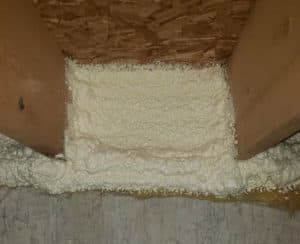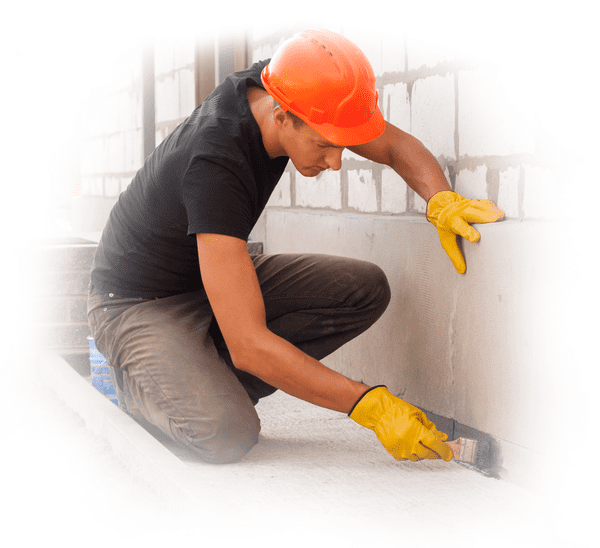To borrow an old line from realtors, “it’s all about location, location, location.” Spray foam insulation is the ideal way to insulate your crawl space, as long as it’s applied to the right locations. If it’s done poorly, it can be a waste of money -or worse- it could actually cause damage.
Acculevel is a family-owned and operated company that specializes in foundation repair and waterproofing. Founded by Andy Beery in 1996, we’ve helped more than 35,000 homeowners restore health and strength to their homes. If you have fiberglass insulation in your crawl space, we strongly urge you to replace it with spray foam. In our experience, this is a much safer and healthier alternative!
In this blog, we’re going to explain why we’re such fans of spray foam insulation, where it should be installed, and provide resources to help you maintain your home in its optimal condition.
What’s Wrong with Fiberglass Insulation?
There’s nothing “wrong” with fiberglass insulation, as long as it’s installed properly and not inside your crawl space.
Until spray foam insulation was introduced to the market, the number one way people insulated was with fiberglass insulation. This is the brightly colored batting-style insulation that you’re probably familiar with. Historically, it’s been placed between a number of structural supports: studs in the walls, rafters in the ceiling, and floor joists in your crawl space.
Fiberglass insulation is relatively inexpensive, but it’s a hazardous substance. You need to wear protective gear when handling it, and it definitely should not be placed where children or pets can access it. But in some parts of your home, it’s a reasonable product to use.
However, as we’ve already mentioned, it’s a very bad idea in a crawl space. This is because underground spaces are frequently damp, and when fiberglass insulation gets damp, it absorbs moisture. So if you have fiberglass insulation installed below your subfloor and it’s damp, what happens to your plywood subfloor? And the wooden joists? And the log-sized main beam? They are also going to get damp, and damp wood rots.
If you have more questions about the hazards of damp insulation, we explore this topic more thoroughly in this article.
Why Is Spray Foam Insulation Better than Fiberglass Insulation?
Spray foam is more expensive than fiberglass, so it may not be an economical choice for your entire home. But we strongly recommend you replace any fiberglass insulation in your crawl space with spray foam.
Spray foam insulation is a mixture of chemicals that are applied to a surface. As the chemicals mix, they create a reaction that foams up and fills every possible gap, crack, or opening. This makes it a very effective insulator; it seals completely and sets almost immediately. Unlike fiberglass insulation, spray foam cannot and will not absorb water. Spray foam also won’t support biological growth like mold or mildew.
Because spray foam sets up so quickly and is so dense, it’s actually very difficult to move or remove. You don’t want to spray it on anything unless you’re sure that’s where you want it! But this rigidity also means it’s difficult for insects or rodents to tunnel through. And it’s not a soft material that pests will shred for nest materials, either. These are all major selling points for an exposed underground space like your home’s crawl space.
Where Should You Apply Spray Foam Insulation In Your Crawl Space?
The best place to apply spray foam insulation is in the joist box. This is the weakest point in your crawl space, because it’s the component that is most exposed to the outside.
What is a Joist Box?
The joist box is the gap between the floor joists, along the outside wall. Floor joists are the supports that span the length of your home. The ends of the joists rest on the sill plate, which is the board installed directly onto the top of your concrete foundation.
Depending on building codes and materials used, the joists are between 10-18 inches apart. That gap between joists is what forms the joist box.

This is a diagram of your home’s flooring structure, courtesy of NCSU.
You can see in the diagram above that there is a wavy line labeled “insulation.” This is exactly where we recommend you install spray foam insulation.
Why Should You Insulate the Joist Box?
We mentioned that the joist box was the “weakest” point in your flooring. This is because the back of the joist box is the band joist. (This can also be called a band board.) It is one single board, and all that separates the ends of the joists from the outside.
Depending on your home’s foundation and structure, there might be siding on the outside that covers the band joist. But if your crawl space is entirely underground, it’s more likely that there’s bare soil pressed against that band joist.
Wood is not a great insulator. The chill and the damp from the ground will seep into the wood, allowing it to lower the temperature of your crawl space. The rest of your foundation is concrete, stone, or brick; these are all much better insulating materials than wood. By installing the spray foam insulation into the joist box, you’re closing the only “gap” in your crawl space’s defenses.

This photo was taken by an Acculevel team member, after installing spray foam insulation in a customer’s crawl space.
Why Shouldn’t You Cover the Entire Flooring with Spray Foam?
You should minimize how much wood is covered with spray foam, because the foam will completely cover and seal a surface. It’s an inorganic material that is not porous and entirely blocks air flow.
So if you spray foam the entire floor joist, you will keep water and insects out. But you can also trap things inside with the joist.
Wood Can Rot or Decay Under Spray Foam Insulation
If there is any dampness in the wood, it has to be allowed to evaporate. Evaporation is the only way to get the moisture out of the joists. They’re not towels that you can wring out (and if they were, they’d make terrible floor supports!).
Moisture in a crawl space is one of the primary reasons we recommend that you install a whole-home dehumidifier in your crawl space. It controls and limits the humidity level of the space, which is the best way to maintain clean and healthy air throughout your home.
If you have actual water in your crawl space- even if it’s only in the spring, or during heavy rains- you should install a water drainage system as well. Your crawl space should be dry, and if it isn’t, you could be looking at some very expensive and invasive repairs in the future.
Want to Learn More About Crawl Space Maintenance?
We’ve written a detailed and thorough homeowner’s guide to crawl space repairs. This resource is available for free to anyone who needs answers about their home’s crawl space. You can bookmark it, read only the sections that matter to you right now, and come back to it later when something else provokes concerns. Or you can be ambitious and read the entire thing, cover to cover!
Do You Want a Quote on Spray Foam Insulation for Your Home?
If you have fiberglass insulation in your crawl space, and want to have this replaced, give Acculevel a call! Proudly serving Indiana and portions of the surrounding states, we will schedule an appointment with one of our knowledgeable and experienced project advisors.
Your assigned project advisor will meet with you, discuss your concerns and any symptoms or signs you’ve noticed, then thoroughly evaluate your home. Once the assessment is complete, they will then review their findings, recommendations, and options. As a team, you and your advisor will determine the ideal whole-home solution for you.
Screening your phone calls? Prefer written communication? Complete our online form and let us know that you’d rather chat by text or email!
If you don’t live in our service area, but need help finding a good reputable contractor, we have advice and resources for that, too! Make certain anyone you work with is properly insured and accredited by the Better Business Bureau, and feel free to use our downloadable checklist of questions to ask a contractor.




















